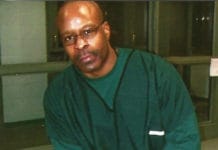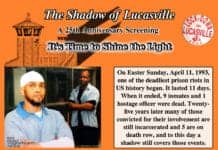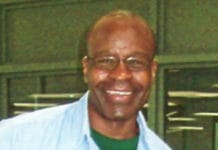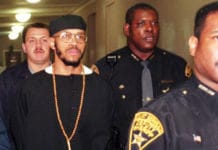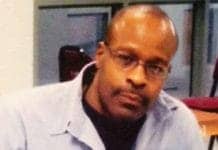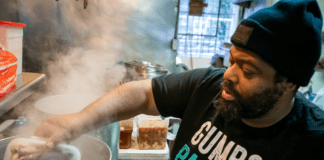The Re-Examining the Lucasville Uprising Conference, held April 19-21 in Columbus, Ohio, to mark the 20th anniversary of the Lucasville Uprising, was a resounding success by all reports. “A strong and vibrant coalition has come together to advocate for innocence of those convicted in the aftermath of the uprising,” reports Noelle Hanrahan of Prison Radio, one of the organizers.
She recommends that readers “visit www.re-examininglucasville.org for information on the prisoner leaders and prisoners’ spokesmen, who were immediately targeted and framed up. Five men are facing the death penalty and a dozen more have long prison terms, including the tortuous death of life without the possibility of parole (LWOP).”
Here are the statements delivered at the conference from prison by Bomani Shakur and in person by Staughton Lynd.
From Bomani Shakur

Before I speak my piece tonight and express what’s going on inside of me, I want to first extend my heartfelt gratitude to each and every one of you.
I am aware that there are any number of places that you all could be on this Friday evening. And so it means a lot to me that you are here to mark this very important occasion with us.
By anyone’s estimation, 20 years is a long time. But 20 years spent in solitary confinement is torture.
In all this time, we have yet to tell our side of the story. In a very real sense, we have been silenced, held incommunicado, while we move ever closer to being executed.
Well, enough is enough. By the time you hear this message, we will have been on hunger strike for over a week now, protesting the unfair and unreasonable refusal by the state to allow us access to the media.
It’s time for the public to hear our voices. It’s time for you all to hear our side of the story.
By anyone’s estimation, 20 years is a long time. But 20 years spent in solitary confinement is torture.
As many of you may or may not know, there was no physical evidence linking anyone to crimes. No fingerprints, no DNA or any other kind of forensic evidence that conclusively connected anyone to any of the crimes that were committed during the 11-day uprising.
This means the state had to rely solely on the testimony of individuals who, from the very outset, were lacking in credibility.
Yet, and still, a guard was killed and somebody had to pay for that. However, with no physical evidence linking anyone to the crimes, the question inevitably becomes, “How does one manufacture credibility and bring to justice those responsible?” This was the formidable task that was taken on by the state.
In almost every case arising out of the disturbance of 1993, there were multiple versions of what actually occurred, and multiple individuals who, for various reasons, were willing to testify to different versions of the truth. So who to believe?
“What made one would-be witness more credible than the next?” This is the question to ask.
In my particular case, the state called more than six witnesses against me who testified, under oath, that they saw me murder and/or order the deaths of five inmates, and they made it appear as though the testimony given by these individuals was irrefutable. And in a certain sense it was. Not because what was said about me was true, but because they prevented me from putting forth testimony that refuted their rendering of the facts.

When my attorneys made the request in discovery for statements that tended to point the finger at someone else, the prosecutor refused to turn over these damning statements, and there were many. Indeed, for every witness who testified against me, there was a witness who claimed to have seen someone else commit the very crimes for which I was ultimately sentenced to death. Unfortunately, the jury in my case never got the opportunity to hear from these witnesses.
Indeed, it wasn’t until my case was over and I was already sitting on death row that I even learned of these conflicting and damning statements. But it was too late by then.
“So why, then, am I rehashing all of this now?” you may ask. “What do we possibly hope to gain by asking you all here tonight?”
Well, since we didn’t receive fair trials through the criminal justice system, we intend to retry our cases in the court of public opinion. Since, when all is said and done, the ultimate outcome – be it freedom or death – will be carried out in your name. It’s to you, the public, that we must now turn.
Out of the five men who were sentenced to death, my case is the furthest along in terms of being resolved.
In late December of 2012, I filed my last appeal, moving me one step closer to the execution chamber.
Since we didn’t receive fair trials through the criminal justice system, we intend to retry our cases in the court of public opinion.
If the state has its way, they are going to kill me soon. However, inasmuch as my life is not for them to take, I intend to fight them, to stand up and speak truth to the power that has delivered me to this evening.
I … no … we need your help.
I’ve written a book called “Condemned.” In it, I lay out the particulars of my case and the overall injustice that occurred. Please read it and, if you believe it and if what you hear over this long weekend rings true, join us in our efforts to right these wrongs. We can stop this thing. I’m innocent. The state of Ohio is trying to kill me.
Send our brother some love and light: Keith LaMar (Bomani Shakur), 317-117, P.O. Box 1436, Youngstown OH 44501.
From Staughton Lynd
Our focus this morning has been a detailed discussion of what happened before and during the 11 days and in the trials that followed. My comments are intended to build a bridge between that analysis and the broader perspectives that will be offered this afternoon. I will divide my remarks in four parts.
First, I shall recall the three biggest prison rebellions in recent United States history. I will suggest that while we are just beginning to build a movement outside the walls of both prisons and courtrooms, there are particular aspects of the Lucasville events that help to explain why that has been so hard.
Second, I will make the case that, despite appearances, Ohio’s prison administration was at least as responsible as were the prisoners for the 10 deaths during the occupation of L block.
Third, I shall describe the manipulation by means of which the state of Ohio induced a leader of the uprising to become an informer and to attribute responsibility for the murder of hostage Officer Robert Vallandingham to others. I shall add that to this day the state says it does not know who the hands-on killers were.
Finally, and very briefly, because I recognize this will be the agenda for tomorrow morning, I will ask: What is to be done?
Three prison uprisings
There have been three major prison uprisings in the United States during the past half century.

Initially the state of New York, including Gov. Nelson Rockefeller, claimed that the hostage officers who died in the yard had their throats cut by the prisoners in rebellion. A courageous medical examiner said, No, the officers all died of bullet wounds. And only one side in the conflict, or massacre, had guns.
Because the brazen cover story of the authorities was so soon and so dramatically refuted, the prosecution of prisoners at Attica never got far off the ground. On Dec. 31, 1976, a little more than five years after the events at the prison, New York Gov. Carey declared by executive order an amnesty for all participants in the insurrection. He stated in part:
“Attica has been a tragedy of immeasurable proportions, unalterably affecting countless lives. Too many families have grieved, too many have suffered deprivations, too many have lived their lives in uncertainty waiting for the long nightmare to end. For over five years and with hundreds of thousands of dollars and countless man-hours, we have followed the path of investigation and accusation. … To continue in this course, I believe, would merely prolong the agony with no better hope of a just and abiding conclusion.”
The governor concluded by saying that his actions should not be understood to imply “a lack of culpability for the conduct at issue.” Rather, Gov. Carey stated, “These actions are in recognition that there does exist a larger wrong which transcends the wrongful acts of individuals.”
In 1980 a second major uprising occurred at the state prison in Santa Fe, New Mexico. Again there were numerous deaths, but all 33 homicides resulted from prisoners killing other prisoners. No officers were murdered. No prisoner was sentenced to death.
Finally we come to the Southern Ohio Correctional Facility in Lucasville in 1993. In trying to understand the tangle of events we call “Lucasville,” one confronts: a prisoner body of more than 1,800, a majority of them Black men from Ohio’s inner cities, guarded by correctional officers largely recruited from the entirely, or almost entirely, white community in Scioto County; a prison administration determined to suppress dissent after the murder of an educator in 1990; an 11-day occupation by more than 400 men of a major part of the Lucasville prison; 10 homicides, all committed by prisoners, including the murder of hostage officer Robert Vallandingham; dialogue between the parties ending in a peaceful surrender; and about 50 prosecutions, resulting in five capital convictions and numerous other sentences, some of them likely to last for the remainder of a prisoner’s life.
The task for defense lawyers and for a community campaign demanding reconsideration, is more difficult than at Attica or Santa Fe. At Attica, 10 of the 11 officers who died were killed by agents of the state. At Santa Fe, only prisoners were killed. Lucasville presents a distinct challenge: the killing of a single hostage correctional officer by prisoners in rebellion.
Who is to blame?
In a summary booklet Alice and I have produced, entitled “Layers of Injustice,” we argue that the Lucasville prisoners in L block, considered collectively, and the state of Ohio share responsibility for the tragedy of April 1993. Both sides contributed to what happened. Events spun out of control. Neither side intended what occurred.
The collective responsibility of prisoners in L block seems self-evident. Ten men were killed. The victims were unarmed and helpless. In contrast to what happened at Attica, all 10 victims were killed by prisoners.
However, Muslim prisoner Reginald Williams, a witness for the state in the Lucasville trials, testified that the hope of the group that planned the 1993 occupation was to carry out a brief, essentially peaceful, attention-getting action “to get someone from the central office to come down and address our concerns” (State v. Were I at 1645), “to barricade ourselves in L-6 until we can get someone from Columbus to discuss” alternative means of doing the TB tests (State v. Sanders at 2129). Siddique Abdullah Hasan, supposed by the state to have planned and led the action, said the same thing to the Associated Press within the past two weeks.
Since the prisoners, whatever their initial intentions, nonetheless carried out the homicides, the responsibility of the state is less obvious. Here are some of the main reasons I believe that the state of Ohio shares responsibility for what happened at Lucasville in 1993.
- In 1989, Warden Terry Morris asked the Legislative Oversight Committee of the Ohio General Assembly to prepare a survey of conditions at the Southern Ohio Correctional Facility in Lucasville. The Correctional Institution Inspection Committee received letters from 427 prisoners and interviewed more than 100. Such was the state of disarray in 1989 that, four years before the 1993 uprising, the CIIC reported that prisoners “relayed fears and predictions of a major disturbance unlike any ever seen in Ohio prison history.”
- After the murder of educator Beverly Jo Taylor in 1990, a new warden was appointed. Warden Arthur Tate instituted what he called “Operation Shakedown.” A striking example of the pervasive repression reported by prisoners is that telephone communication between prisoners and the outside world was limited to one five-minute outgoing telephone call per year.
- The single feature of life at Lucasville that the CIIC found most troublesome was the prison administration’s use of prisoner informants, or “snitches.” Warden Tate, “King Arthur” as the prisoners called him, expanded the use of snitches. In 1991 the warden addressed a letter to all prisoners and visitors in which he provided a special mailing address to which alleged violations of “laws and rules of this institution” could be reported. Six alleged snitches, a majority of the persons murdered during the rebellion, were killed in the first hours of the disturbance.
- The immediate cause or trigger of the rebellion was Warden Tate’s insistence on testing for TB by injecting a substance containing phenol, which a substantial number of Muslim prisoners believed to be prohibited by their religion. Alternative means of testing for TB by use of X rays or a sputum test were available and had been used at Mansfield Correctional Institution. In its post-surrender report, the correctional officers’ labor union stated that Warden Tate was “unnecessarily confrontational” in his response to the Muslim prisoners’ concern about TB testing using phenol.
- Before Warden Tate departed for the Easter weekend on Good Friday, three of his administrators advised against his plan to lock the prison down and forcibly inject prisoners who refused TB shots. The warden did not adequately alert the reduced staff who would be on duty as to the volatile state of affairs. Slow response to the initial occupation of L block let pass an early opportunity to end the rebellion without loss of life. It was two hours after the insurgency began before Warden Tate was notified. The safewells at the end of each pod in L block, to which correctional officers retreated as they had been instructed, turned out to have been constructed without the prescribed steel stanchions and were easily penetrated.
- Sgt. Howard Hudson, who was in the administration control booth during the 11 days and was offered by prosecutors as a so-called “summary witness,” conceded in his trial testimony that the state of Ohio deliberately stalled when prisoners tried to end the standoff by negotiation. Hudson testified in Hasan’s case: “The basic principle in these situations … is to buy time. … [T]he more time that goes on the greater the chances for a peaceful resolution to the situation.” This assumption proved – to use an unfortunate phrase – to be dead wrong.
- By cutting off water and electricity to the occupied cell block on April 12, the state created a new cause of grievance. The prisoners’ concern to get back what they had at the outset of the disturbance became the sticking point in unsuccessful negotiations to end the standoff before Officer Vallandingham was murdered.
- On the morning of April14, spokeswoman Tessa Unwin made a statement to the press on behalf of the authorities. Ms. Unwin was asked to comment on a message written on a sheet that was hung out of an L block window threatening to kill a hostage officer. Rather than responding “No comment,” she stated: “It’s a standard threat. It’s nothing new. . . They’ve been threatening things like this from the beginning.” According to several prisoners in L block and to hostage officer Larry Dotson, this statement inflamed sentiment among the prisoners who were listening on battery-powered radios. In the judgment of the officers’ union, in their report on the disturbance:
As anyone familiar with the process and language of negotiations would know, this kind of public discounting of the inmate threats practically guaranteed a hostage death.
When an official DR&C spokesperson publicly discounted the inmate threats as bluffing, the inmates were almost forced to kill or maim a hostage to maintain or regain their perceived bargaining strength. - In 2010, documentary filmmaker Derrick Jones interviewed Daniel Hogan, who prosecuted Robb and Skatzes and is now a state court judge. Hogan told Jones on tape: “I don’t know that we will ever know who hands-on killed the corrections officer, Vallandingham.” Later Mr. Jones asked former prosecutor Hogan: “When it comes to Officer Vallandingham, who killed him?” Judge Hogan replied: “I don’t know. And I don’t think we’ll ever know.” Nonetheless, four spokespersons and supposed leaders of the uprising have been found guilty of the officer’s aggravated murder and sentenced to death.
Who did kill Officer Vallandingham?
With the help of Attorney Niki Schwartz, three prisoner representatives accepted a 21 point agreement and a peaceful surrender followed. The agreement stated in Point 6, “Administrative discipline and criminal proceedings will be fairly and impartially administered without bias against individuals or groups.” Point 14 added, “There will be no retaliatory actions taken toward any inmate or groups of inmates.”

“They made it clear they wanted the leaders. They wanted to prosecute Hasan, George Skatzes, Lavelle, Jason Robb and another Muslim. They had not yet begun their investigation but they knew they wanted those leaders. I joked with them and said, ‘You basically don’t care what I say as long as it’s against these guys.’ They said, ‘Yeah, that’s it.’”
Newell named the men who had interrogated him: Lt. Root, Sgt. Hudson, and Troopers McGough and Sayers. According to Newell:
“These officers said, ‘We want Skatzes. We want Lavelle. We want Hasan.’ They also said, ‘We know they were leaders. … We want to burn their ass. We want to put them in the electric chair for murdering Officer Vallandingham.’”
With the same motivation, the prosecutors pursued a more sophisticated strategy. ODRC Director Reginald Wilkinson put it this way in an article that he co-authored with his associate Thomas Stickrath for the Corrections Management Quarterly:
“According to Special Prosecutor Mark Piepmeier, his staff targeted a few gang leaders. … Thirteen months into the investigation, a primary riot provocateur agreed to talk about Officer Vallandingham’s death. … His testimony led to death sentences for riot leaders Carlos Sanders [Hasan], Jason Robb, James Were and George Skatzes.”
The so-called primary riot provocateur was prisoner Anthony Lavelle, leader of the Black Gangster Disciples, who, along with Hasan and Robb, had negotiated the surrender agreement.
How did the state induce Lavelle not only to talk, but to say what the prosecution desired?
During the winter of 1993-1994, Hasan, Lavelle and Skatzes were housed in adjacent cells at the Chillicothe Correctional Institution. On April 6, 1994, Skatzes was taken to a room where he found Sgt. Hudson, Trooper McGough of the Highway Patrol and two prosecutors. This was the third such occasion and, as twice before, Skatzes said that he did not wish to continue the interview and turned to go back to his cell in the North Hole.
What happened next, according to Skatzes, was that Warden Ralph Coyle entered the room and said that Central Office did not want Skatzes to go back to the North Hole. Skatzes protested vehemently that this would make him look like a snitch. Coyle was adamant and Skatzes was led away to a new location.
Back in the North Hole, Lavelle reacted exactly as Skatzes feared. Lavelle wrote a letter to Jason Robb that became an exhibit in Robb’s trial: “Jason: I am forced to write you and relate a few things that happen down here lately. With much sadness I will give you the raw deal, your brother George has done a vanishing act on us. … On Wednesday, April 6, 1994, G. said about 8:00 a.m. that he had a lawyer visit . … Now to be short and simple, he failed to return that day. Today they came and packed up his property which leads me to one conclusion that he has chose to be a cop.”
Later, Lavelle himself testified that he turned state’s evidence because he thought he would go to Death Row if he did not. This was an accurate assessment. Prosecutor Hogan told a trial court judge at sidebar that his colleague Prosecutor Stead had told Lavelle, “Either you are going to be my witness or I’m going to try to kill you.” According to the testimony under oath of prisoner Anthony Odom, who celled across from Lavelle at the time, Lavelle entered into his plea agreement, Lavelle “said he was gonna cop out [be]cause the prosecutor was sweating him, trying to hit him with a murder charge. … He said he was going to tell them what they wanted to hear.”
Lavelle was understandably concerned that the prosecutor might hit him with a murder charge because it is overwhelmingly likely that it was, in fact, he who coordinated Officer Vallandingham’s murder. I have laid out the evidence in my book and in an article in the Capital University Law Review. Briefly,
Three members of the Black Gangster Disciples stated under oath that Lavelle tried to recruit them for a death squad after Ms. Unwin’s statement on April 14;
Sean Davis, who slept in L-1 as Lavelle did, testified that when he awoke on the morning of April 15, he heard Lavelle telling Stacey Gordon that he was going to kill a guard, to which Gordon replied that he would clean up afterward;
The late James Bell, a.k.a. Nuruddin, executed an affidavit before his death to the effect that Lavelle had left the morning meeting on April 15 furious that the Muslims and Aryans were unwilling to kill a hostage officer;
Three prisoners saw Lavelle and two other Disciples come down the L block corridor from L-1 and go into L-6, leaving a few minutes later;
James Were, on guard duty in L-6 and thereby an eyewitness to the murder, went to L-1 when he learned that the action had not been approved by other riot leaders and knocked Lavelle to the ground. Willie Johnson and Eddie Moss heard Were explicitly blame Lavelle for the killing;
Two older and, in my opinion, reliable convicts, Leroy Elmore and the late Roy Donald, say that on April 15 Lavelle told each of them in so many words that he had had the guard killed.
Unlike prisoners who testified for the state, the 12 men whose evidence I have summarized received no benefits for coming forward and, in fact, risked retaliation from other inmates by doing so. No jury has ever heard their collective narrative.
What is to be done?
So, what can we do?
The first task is to make it possible for the men condemned to death and life in prison to tell their stories, on camera, in face-to-face interviews with representatives of the media.

In telephone calls to the authorities during the first night of the occupation, prisoner representatives proposed a telephone interview with one media representative, or a live interview with a designated TV channel, in exchange for the release of one hostage correctional officer. At 7:00 a.m. on Monday, April 12, the prisoners in rebellion broke off telephone negotiations, demanding local and national news coverage before any hostage release.
In the late morning of April 12, George Skatzes volunteered to go out on the yard, accompanied by Cecil Allen, carrying an enormous white flag of truce. The men asked for access to the media already camped outside the prison walls.
When on April 15 and 16 the prisoners released hostage officers Darrold Clark and Anthony Demons, what did they ask for and get in return? The opportunity for one spokesperson, Skatzes, to make a radio address and for another, Muslim Stanley Cummings, to speak on TV the next morning.
Now the Lucasville prisoners are again knocking on the door of the state, hunger striking, crying out against their isolation from the dialogue of civic society. They ask, “Why are we being kept incommunicado? What is the state afraid of?”
The first task is to make it possible for the men condemned to death and life in prison to tell their stories, on camera, in face-to-face interviews with representatives of the media.
I urge all present not to be distracted by official talk about alternative means of communication. The state tells us that the men condemned to death can write letters and make telephone calls. But the media access that these prisoners seek is the kind of exchange that can occur in courtroom cross-examination. The condemned are saying to us, “Before you kill me, give me a chance to join with you in trying to figure out what actually occurred.”
These are not homicides like that of which Mumia Abu Jamal is accused or that for which Troy Davis was executed: homicides with one decedent, one alleged perpetrator, and half a dozen witnesses. This is an immense tangle of events.
There is no objective evidence except for the testimony of the medical examiners, which repeatedly contradicted the claims of the prosecution. Very few physical objects remain in existence. The medical examiner testified that David Sommers was killed by a single massive blow with an object like a bat. A bloody baseball bat was found near the body of David Sommers. Special Prosecutor Mark Piepmeier ordered the bat to be destroyed.
We need media access to the Lucasville Five and their companions not just to perceive them as human beings, but to determine the truth. George Skatzes and Aaron Jefferson were tried in separate trials and each was convicted of striking the single massive blow that killed Mr. Sommers.
Eric Girdy has confessed to being one of the three killers of Earl Elder, using a shank made of glass from the mirror in the officers’ restroom, and slivers of glass were found in one of the lethal wounds and on the nearby floor. Girdy has insisted under oath that Skatzes had nothing to do with the murder; yet the state, while accepting Girdy’s confession, has not vacated the judgment against Skatzes.
Hasan and Namir were found not guilty of killing Bruce Harris, yet Stacey Gordon, who admitted to being one of the killers, is on the street.
The trial court judge in Keith LaMar’s trial refused to direct the prosecution to turn over to counsel for the defense the transcripts of all interviews conducted by the Highway Patrol with potential witnesses of the homicides for which LaMar was convicted, and LaMar is now closest to death of the five.
Jason Robb did nothing to cause the death of Officer Vallandingham except to attend an inconclusive meeting also attended by Anthony Lavelle, but only Robb was sentenced to death.
These things are not right, not just, not fair. The men facing death and life imprisonment for their alleged actions in April 1993 need to be full participants in the truth-seeking process. That is why, to repeat, I believe that our first task following this gathering is to make it possible for these men to tell their stories, on camera, in face-to-face interviews with representatives of the media. Journalists, for example from campus newspapers, who wish precise information as to how to request interviews should contact me.
Legendary attorney, professor, historian, author, playwright, and civil rights and peace activist Staughton Lynd can be reached at salynd@aol.com.

 Store
Store



